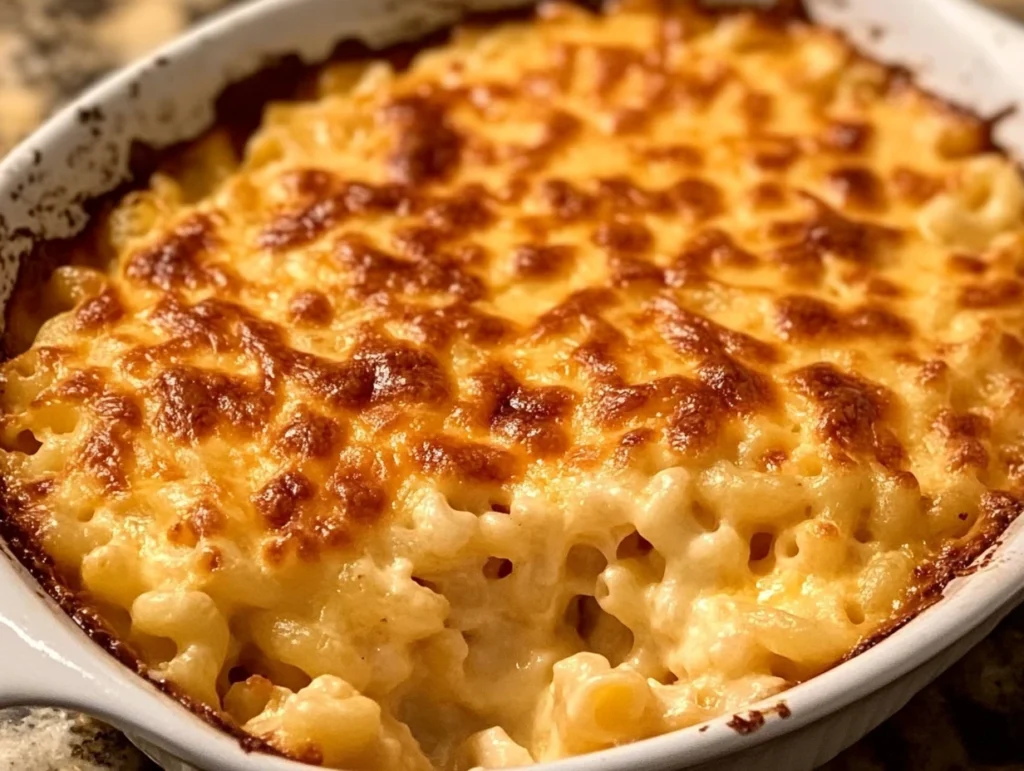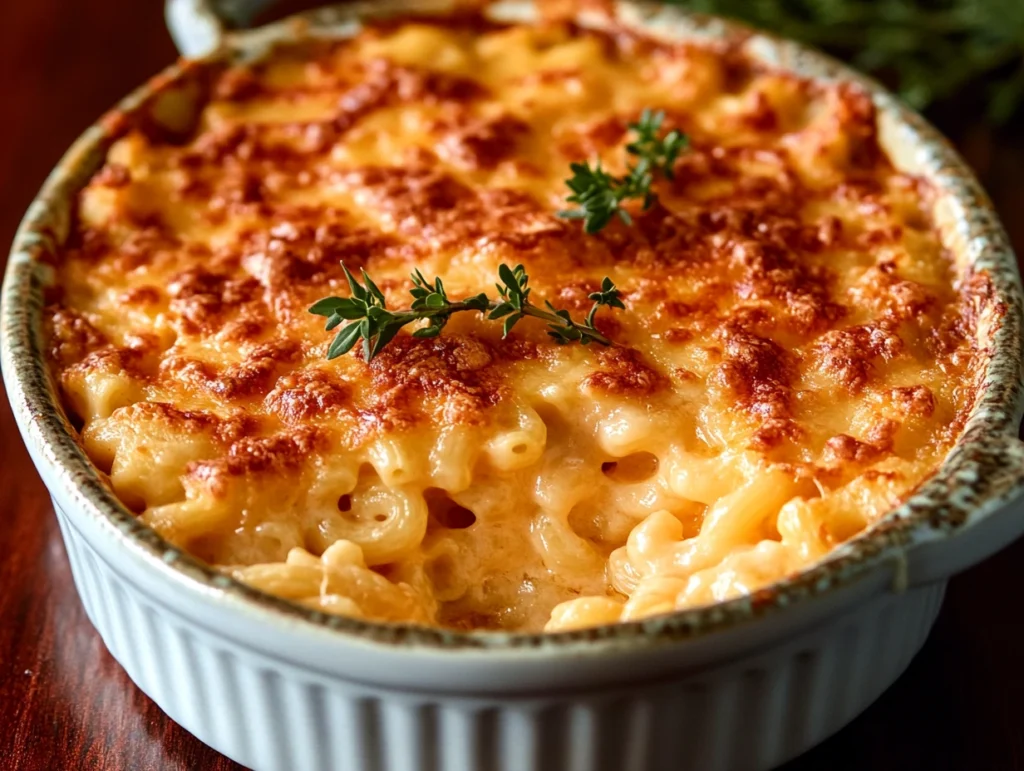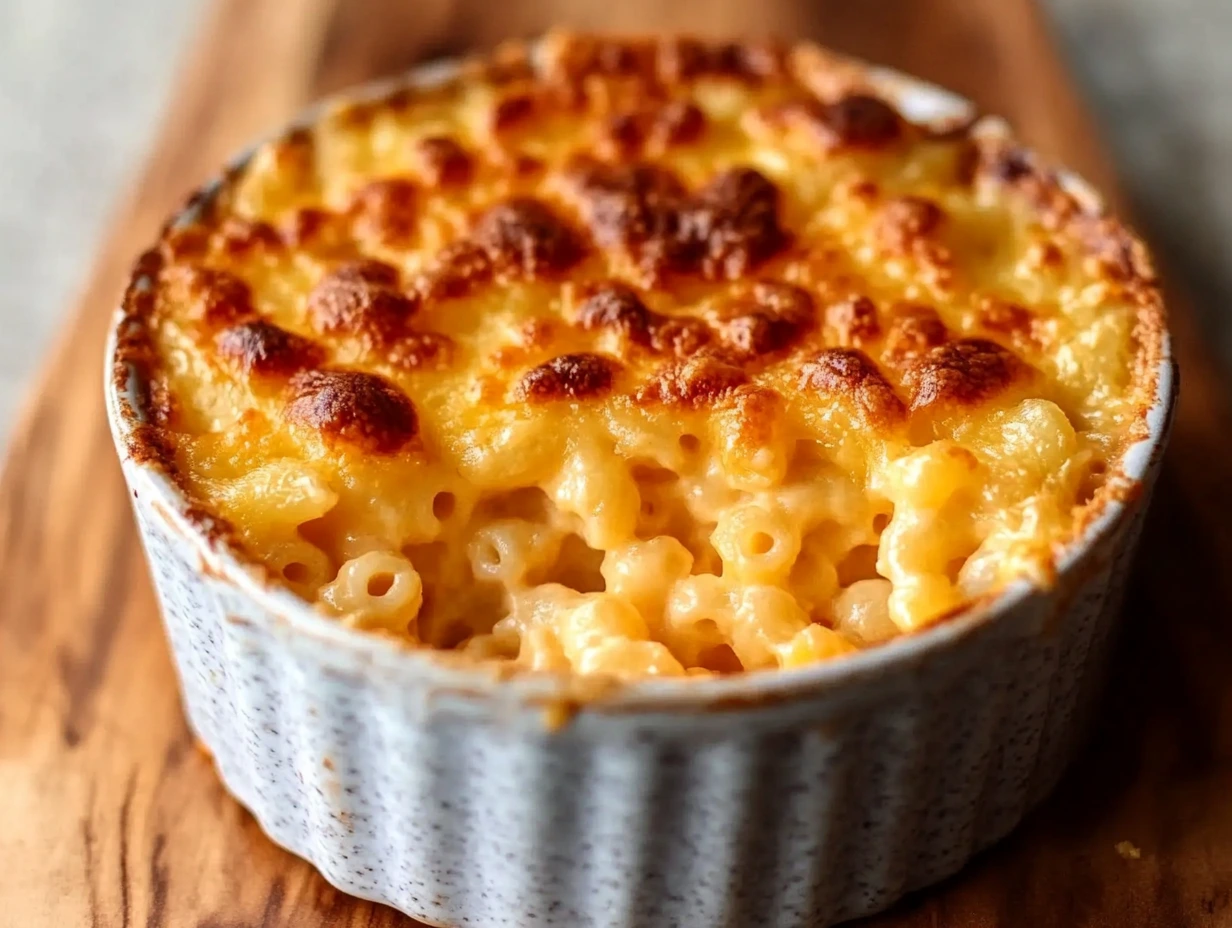There’s something undeniably nostalgic about a warm, bubbling Old-fashioned baked macaroni and cheese of baked macaroni and cheese. This classic comfort food has stood the test of time, bringing joy to family dinners, potlucks, and holidays for generations. Whether it’s the crispy, golden topping or the creamy, cheesy interior, baked mac and cheese is a dish that transcends trends, offering a taste of home with every bite.
Table of Contents
Why Baked Macaroni and Cheese Is Timeless
Baked macaroni and cheese is more than just a meal—it’s a cultural icon. Its simplicity and versatility make it appealing to everyone, from picky eaters to food connoisseurs. Beyond its taste, the dish is a canvas for creativity, allowing cooks to experiment with different cheeses, spices, and toppings to create their own signature version.
A Brief History of Mac and Cheese
Macaroni and cheese has a storied history that dates back to medieval Europe, where recipes combining pasta and cheese were first documented. Thomas Jefferson is credited with popularizing the dish in America after encountering it during his travels to Italy. Over the centuries, it evolved from a high-society delicacy to an everyday staple, thanks in part to its affordability and the advent of boxed versions in the 20th century.
Modern Twists on a Classic
While the traditional recipe calls for elbow macaroni, cheddar cheese, and a breadcrumb topping, modern variations have taken the dish to new heights. From incorporating gourmet cheeses like Gruyère and Fontina to adding proteins like lobster or bacon, there’s no limit to how creative you can get. Vegan and gluten-free versions have also gained popularity, ensuring that everyone can enjoy this timeless comfort food.

Old-Fashioned Baked Macaroni and Cheese
Ingredients for the Perfect Mac and Cheese
Every great dish starts with quality ingredients, and baked macaroni and cheese is no exception. From the type of cheese to the choice of pasta, each component plays a crucial role in creating that classic, comforting flavor.
Essential Cheeses for the Recipe
The key to a perfect mac and cheese lies in the cheese blend. While sharp cheddar is the classic choice for its bold flavor and creamy melt, combining it with other cheeses elevates the dish. Consider adding:
- Gruyère for a nutty, sophisticated flavor.
- Monterey Jack for extra creaminess.
- Parmesan for a salty, umami kick.
- Fontina for a velvety texture.
Experimenting with a mix of cheeses can yield a rich and complex flavor profile.
Choosing the Right Pasta
Elbow macaroni is the traditional choice, but other pasta shapes work just as well, if not better. Look for shapes that can hold onto the cheese sauce for maximum flavor, such as:
- Cavatappi for a twisty, fun texture.
- Shells to scoop up cheese pockets.
- Penne for a heartier bite.
Always opt for pasta with ridges or grooves to help the sauce cling to the surface.
Optional Add-Ins for Extra Flavor
While the classic recipe is beloved for its simplicity, adding extra ingredients can elevate the dish. Some popular options include:
- Proteins like crispy bacon, shredded chicken, or even lobster.
- Vegetables like roasted broccoli, caramelized onions, or sun-dried tomatoes.
- Spices and Herbs such as smoked paprika, mustard powder, or fresh thyme for added depth.
These additions allow you to tailor the dish to your taste or the occasion.
Step-by-Step Recipe
Creating the perfect baked macaroni and cheese involves several simple steps that ensure creamy, cheesy perfection with a golden, crispy topping.
Preparing the Cheese Sauce
- Make a roux: Melt butter in a saucepan over medium heat, then whisk in an equal amount of flour. Cook for 1–2 minutes until the mixture is golden and slightly nutty.
- Add milk gradually: Slowly pour in warm milk, whisking constantly to avoid lumps.
- Melt the cheese: Once the sauce thickens, lower the heat and stir in the cheese blend until smooth and creamy. Season with salt, pepper, and optional spices like paprika or mustard powder.
Combining Pasta and Sauce
- Cook the pasta: Boil your chosen pasta until just al dente. Drain and rinse under cool water to stop cooking.
- Mix it all together: Combine the pasta with the cheese sauce in a large mixing bowl, ensuring every piece is coated in creamy goodness.
Baking to Perfection
- Assemble the dish: Transfer the pasta and sauce mixture to a buttered baking dish. Top with additional cheese and breadcrumbs for a crispy topping.
- Bake: Place the dish in a preheated oven at 375°F (190°C) for 20–25 minutes or until the top is golden and bubbling.
- Serve: Let it cool for a few minutes before serving to allow the flavors to meld.
Old-Fashioned Baked Macaroni and Cheese
Tips for the Best Baked Macaroni and Cheese
Achieving the perfect baked mac and cheese can be an art form. These tips will help you avoid pitfalls and make your dish stand out every time.
Avoiding Common Mistakes
- Don’t overcook the pasta: Boil the pasta just until al dente, as it will continue cooking in the oven. Overcooked pasta can result in a mushy texture.
- Use freshly grated cheese: Pre-shredded cheese often contains anti-caking agents that can affect the creaminess of your sauce. Freshly grated cheese melts better and tastes fresher.
- Balance the sauce-to-pasta ratio: Avoid dry mac and cheese by ensuring there’s enough sauce to generously coat the pasta. The mixture may seem slightly “too saucy” before baking, but it will set as it cooks.
- Bake just enough: Overbaking can dry out the dish. Bake until the top is golden and bubbling, and then remove it from the oven.
Make-Ahead and Storage Instructions
- Make-ahead: Prepare the dish up to the point of baking, then cover and refrigerate for up to 24 hours. When ready to bake, let it sit at room temperature for 15–20 minutes and bake as directed.
- Freezing: Assemble the mac and cheese without the breadcrumb topping, cover tightly, and freeze for up to 2 months. Thaw overnight in the fridge before adding the topping and baking.
- Storing leftovers: Store leftover baked mac and cheese in an airtight container in the refrigerator for up to 4 days. Reheat in the oven at 350°F (175°C) or in the microwave for single servings.
Variations and Dietary Alternatives
Baked macaroni and cheese is endlessly adaptable. With a few substitutions or additions, you can tailor the dish to suit various dietary needs or explore creative new flavors.
Gluten-Free Version
- Use gluten-free pasta: Opt for a high-quality gluten-free pasta made from rice, corn, or quinoa for the best texture.
- Replace the roux flour: Substitute all-purpose flour with gluten-free flour or cornstarch to thicken the cheese sauce.
- Breadcrumb alternative: Top the dish with gluten-free breadcrumbs or crushed gluten-free crackers for a crispy finish.

Vegan Baked Mac and Cheese
- Choose plant-based milk and cheese: Use unsweetened almond, soy, or cashew milk and a combination of vegan cheeses, such as nutritional yeast, vegan cheddar, or cashew cream.
- Roux substitute: Thicken the sauce with a slurry of plant-based milk and cornstarch instead of a butter-and-flour roux.
- Toppings: Sprinkle nutritional yeast and vegan breadcrumbs mixed with olive oil for a crunchy topping.
Healthier Options
- Swap out the cheese: Use reduced-fat cheese or mix in a small amount of full-flavored cheese to maintain richness with fewer calories.
- Incorporate veggies: Add finely chopped spinach, kale, roasted cauliflower, or sweet potato puree to boost the nutritional content.
- Use whole-grain pasta: Choose whole-grain or high-protein pasta for added fiber and nutrition.
- Lighten the sauce: Replace some of the butter with olive oil and use low-fat milk instead of cream.
Old-Fashioned Baked Macaroni and Cheese
Pairing Suggestions
Baked macaroni and cheese is a versatile side or main dish that pairs beautifully with a variety of flavors. Whether you’re serving it as part of a family dinner or at a special gathering, the right accompaniments can elevate the meal.
Main Courses That Complement Mac and Cheese
- Roasted or Grilled Meats:
- BBQ Ribs or Chicken: The smoky, tangy flavors of barbecue perfectly balance the rich creaminess of mac and cheese.
- Grilled Steak: A juicy steak with a charred crust pairs wonderfully with the cheesy, comforting pasta.
- Herb-Roasted Chicken: A classic pairing that provides a savory, lighter contrast to the richness.
- Seafood Options:
- Baked Salmon: The mild, buttery flavor of salmon complements the boldness of the cheese.
- Fried Catfish or Shrimp: Crispy, seasoned seafood brings texture and depth to the meal.
- Lobster: Pairing mac and cheese with lobster creates an indulgent, luxurious experience.
- Vegetarian Pairings:
- Grilled Portobello Mushrooms: Their meaty texture and earthy flavor make them a perfect complement.
- Roasted Vegetables: Try roasted brussels sprouts, asparagus, or butternut squash for a hearty side.
- Fresh Salad: A crisp, tangy salad with vinaigrette helps cut through the richness.
Beverage Pairings
- Wine:
- Chardonnay: A creamy, oaky Chardonnay mirrors the dish’s richness while adding a touch of acidity.
- Pinot Noir: This light red wine has a bright acidity that balances the heaviness of the cheese.
- Sparkling Wine: A bubbly Prosecco or Champagne offers a refreshing contrast to the creamy mac and cheese.
- Beer:
- Pale Ale: Its bitterness complements the sharpness of the cheese while cutting through the richness.
- Porter or Stout: The roasted malt flavors provide a robust, hearty pairing.
- Lager: A crisp, light lager refreshes the palate without overwhelming the dish.
- Non-Alcoholic Options:
- Iced Tea: A glass of unsweetened or lightly sweetened iced tea adds a cooling, cleansing element.
- Sparkling Water with Citrus: A squeeze of lemon or lime in sparkling water provides a crisp, bright contrast.
- Apple Cider: The sweetness and slight acidity of cider pair beautifully with the cheesy, creamy flavors.

FAQs About Baked Macaroni and Cheese
Whether you’re making baked mac and cheese for the first time or perfecting your recipe, these frequently asked questions can help you troubleshoot and refine your dish.
Can I use pre-shredded cheese?
Yes, but it’s not ideal. Pre-shredded cheese often contains anti-caking agents like starch or cellulose, which can result in a grainy or less creamy sauce. For the best texture and flavor, shred your cheese from a block just before using it.
Why did my cheese sauce curdle?
Curdling happens when the cheese overheats and the fats separate from the proteins. To avoid this:
- Keep the heat low: Melt the cheese over low or medium-low heat.
- Add cheese gradually: Stir in small handfuls at a time, ensuring each is fully melted before adding more.
- Choose good melting cheeses: Avoid cheeses that are prone to separating, like hard-aged varieties (e.g., Parmesan).
How can I reheat leftovers without drying?
To keep leftovers creamy when reheating:
- Add a splash of milk or cream to the mac and cheese before reheating to restore moisture.
- Use gentle heat: Reheat in the oven at 350°F (175°C) covered with foil, or microwave on low power in short intervals, stirring in between.
- Avoid overcooking: Heat just until warm to maintain the creamy texture.
What’s the best type of cheese for flavor?
For bold flavor, sharp cheddar is a go-to. Mixing it with other cheeses like Gruyère (nutty), Fontina (creamy), Monterey Jack (mild), or Parmesan (salty) creates a balanced and rich flavor. Choose a combination of cheeses that melt well and complement each other.
Can I freeze baked macaroni and cheese?
Yes! For the best results:
- Assemble the dish without baking.
- Wrap tightly in plastic wrap and aluminum foil, or use an airtight container.
- Freeze for up to 2 months.
- When ready to serve, thaw in the refrigerator overnight, add toppings like breadcrumbs, and bake as directed.
How do I make it creamier?
To achieve a creamier mac and cheese:
- Use whole milk or cream: These provide a richer base for the cheese sauce.
- Incorporate cream cheese: A small amount adds extra creaminess.
- Don’t skimp on the roux: The flour and butter mixture helps stabilize the sauce, keeping it smooth.
- Undercook the pasta: Slightly undercooked pasta absorbs the sauce as it bakes, ensuring it stays moist and creamy.
Pair your old-fashioned baked macaroni and cheese with a side of macaroni and cheese cups for a creative twist that’s perfect for parties or kids’ lunches. For a gourmet touch, consider serving it alongside grilled lobster tails to create a luxurious surf-and-turf meal. If you’re looking for a hearty one-pot meal, explore recipes like creamy sausage pasta or Cajun sausage pasta that pair beautifully with this cheesy classic. For dessert, satisfy your sweet tooth with a slice of strawberry cheesecake to complete the meal.
Conclusion
Old-fashioned baked macaroni and cheese is more than just a dish—it’s a comforting reminder of home, tradition, and the joy of sharing a meal with loved ones. Whether you stick to the classic recipe or experiment with modern twists, this timeless favorite never fails to delight. Pair it with complementary mains, explore dietary variations, or simply savor it as a standalone treat. With the tips, pairing ideas, and FAQs in this guide, you’re now equipped to make the perfect baked mac and cheese every time. Let this dish bring warmth to your table and smiles to everyone who gathers around it.

